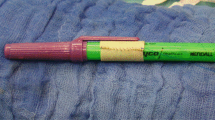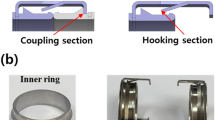Abstract
A retrospective analysis of the long-term behavior of 111 glutaraldehyde-tanned human umbilical vein (HUV) grafts implanted between September 1977 and December 1993 was conducted. A total of 81 patients, with a mean age of 68.7 years, received the grafts and were followed up for between 1 and 131 months. The 5-year primary cumulative patency rate for above-knee femoropopliteal bypass was 83.1%, whereas that of other bypasses was 60.9%. An aneurysm of the graft was defined as a physically apparent localized dilatation, with diffuse ectasia being excluded. There were 11 aneurysms found in 9 grafts, 2 of which arose at the factory-made suture lines. The accumulated incidence of aneurysms had reached 21.9% by the 6th year. One aneurysm compressed the graft and resulted in limb-threatening ischemia and another resulted in frank rupture. Moreover, reinforcement of the mesh could not prevent aneurysm development, the repair of which is mandatory due to the risk of rupture and acute thrombosis. The HUV grafts showed an acceptable patency rate in the above-knee location, but the incidence of aneurysm formation after 5 years was abnormally high. Thus, both the risks and benefits of HUV grafts must be taken into account when considering their clinical application.
Similar content being viewed by others
References
Boontje AH (1986) Angiographic assessment of Biografts for femoropopliteal bypass. J Cardiovasc Surg 27:136–140
Aalders GJ, van Vroonhoven TJMV (1992) Polytetrafluoroethylene versus human umbilical vein in above-knee femoropopliteal bypass: Six-year results of a randomized clinical trial. J Vasc Surg 16:816–824
Rutherford RB, Jones DN, Bergentz SE, Bergqvist D, Comerota AJ, Dardik H, Flinn WH, Fry WJ, McIntyre K, Moore WS, Shah DM, Yano T (1988) Factors affecting the patency of infrainguinal bypass. J Vasc Surg 8:236–246
McCollum D, Kenchington G, Alexander C, Franks PJ, Greenhalgh RM (1991) PTFE or HUV for femoropopliteal bypass: A multi-centre trial. Eur J Vasc Surg 5:435–443
Giordano JM, Keshishian JM (1982) Aneurysm formation in human umbilical vein grafts. Surgery 91:343–345
Hirsch SA, Jarrett F (1984) The use of stabilized human umbilical vein for femoropoliteal bypass. Experience with 133 operations with 5-year follow-up. Ann Surg 200:147–152
Motta G, Ratto GB, Sacco A, Canepa G (1986) Our eight-year experience with human umbilical vein grafts. J Cardiovasc Surg 27:709–713
Miyata T, Tada Y, Takagi A, Sato O, Oshima A, Idezuki Y, Shiga J (1989) A clinicopathlogical study of aneurysm formation of glutaraldehyde-tanned human umbilical vein grafts. J Vasc Surg 10:605–611
Jarret F, Hirsch SA (1989) Reoperation for complications of stabilized human umbilical vein grafts. Am J Surg 158:438–442
Boontje AH (1985) Aneurysm formation in human umbilical vein grafts used as arterial substitutes. J Vasc Surg 2:524–529
Karkow WS, Cranley J, Cranley RD, Hafner CD, Ruoff BA (1986) Extended study of aneurysm formation in umbilical vein grafts. J Vasc Surg 4:486–492
Hasson JE, Newton WD, Waltman AC, Fallon JT, Brewster DC, Darling RC, Abbot WM (1986) Mural degeneration in the glutaralde hyde-tanned umbilical vein graft: Incidence and implication. J Vasc Surg 4:243–250
Sommeling CA, Buth J, Jakimowicz JJ (1990) Long-term behavior of modified human umbilical vein grafts; Late aneurysmal degeneration established by colour-duplex scanning. Eur J Vasc Surg 4:89–94
Nevelsteen A, Smet G, Wilms G, Marchal G, Suy R (1988) Intravenous digital subtraction angiography and duplex scanning in the detection of late human umbilical vein degeneration. Br J Surg 75:668–670
Author information
Authors and Affiliations
Rights and permissions
About this article
Cite this article
Sato, O., Okamoto, H., Takagi, A. et al. Biodegradation of glutaraldehyde-tanned human umbilical vein grafts. Surg Today 25, 901–905 (1995). https://doi.org/10.1007/BF00311756
Received:
Accepted:
Issue Date:
DOI: https://doi.org/10.1007/BF00311756




